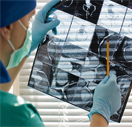Optimized method of antigrade pyelo-ureterography for exact localization of complete uretic occlusion
Gábor FILKOR
Department of Urology, Semmelweis University, Budapest, Hungary
Introduction: In case of total or subtotal occlusion of the ureters
contrast medium during the antegrade pyelography procession can
hardly reach the end point of the occlusion leading to diagnostical
errors if the examination is performed through the classic method
of filling the pyelum with a syringe. Also the amount of contrast
medium to use is doubtful because small amounts are ineffective,
however large amounts can raise pyelar pressure to a dangerous
level causing pyelo-tubular reflux and bacteraemia. We performed
a new method for antegrade pyelography so that we can eliminate
disadvantages of high-pressure direct syringal filling of the pyelum
and ineffective diagnostical process.
Patients and methods: We performed pressure-controlled antegrade
pyelography in standing position in 16 cases in 2006. Every
patients was inserted a transrenal drain due to the suspicion of
total ureteral obstruction and threatening of infection some days before. We performed the examination after the acute period, free
of fever. First the patient lied in horizontal position. We filled the
pyelum with 10 ml non-ionic iodine contrast medium administered
the syringe directly to the transrenal drain and shooting an X-ray
film from the kidney. Then in a standing position the drain with the
emptied urine-bag was conducted over the ipsilateral shoulder from
front to back. We inserted an 18G-needle 30-40 cm over the spot
of puncture. A syringe fulfilled with 20 ml of non-ionic iodine contrast
medium was connected to the needle. Gently press the piston
the pyelum was filled with the contrast medium in a manner that
the fluid-column could not reach more than 15 cm in the drain so
that high pressure in the pyelum could not have arisen. After 5
minutes walking the second X-ray film was shot.
Results: The spot of occlusion of the ureter was seldom shown
by the first X-ray film. The contrast medium could not mix with
the urine in the pyelum and ureter and intrapyelar pressure could
reach dangerous levels. In the other hand during pressure controlled
filling of the pyelum high pressures could be avoided and
during the 5 minutes -spent in the vertical position- higher specific
weight contrast medium could stream to the end of ureter
showing stop position of occlusion or could pass through the
subtotal occlusion appearing in the bladder too in every case.
Conclusion: Pressure controlled antegrade pyelography is a safe
and reliable diagnostic method in case of ureteral occlusion with
higher diagnostic effect and less iatrogenic complications. We suggest
that this method can also be safely used in case of
pyelonephritis because pyelo-parenchymal reflux can be avoided
by pressure control.




